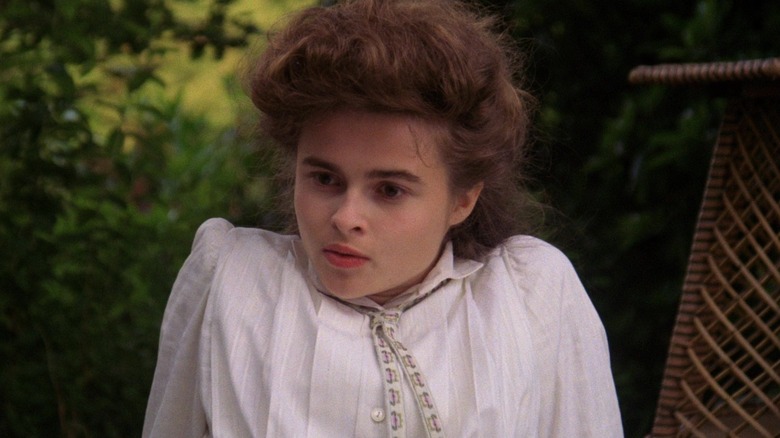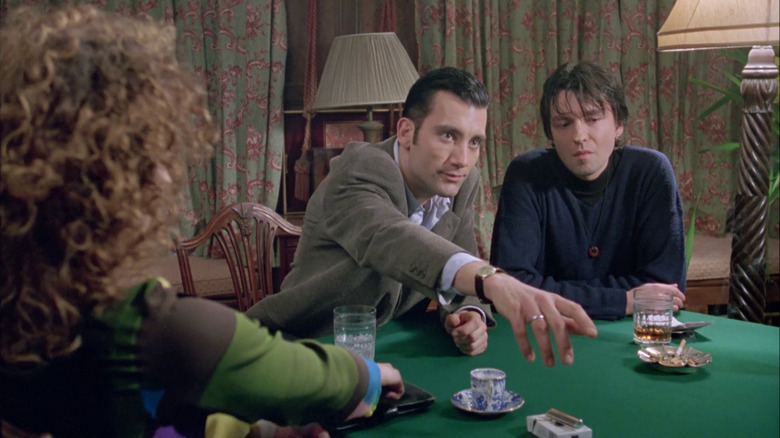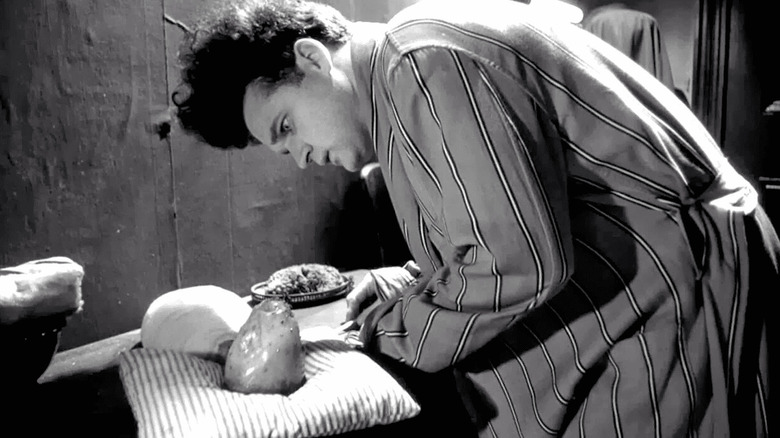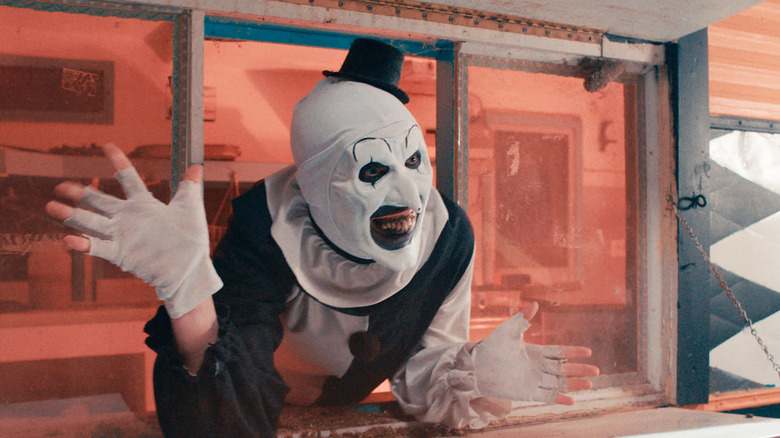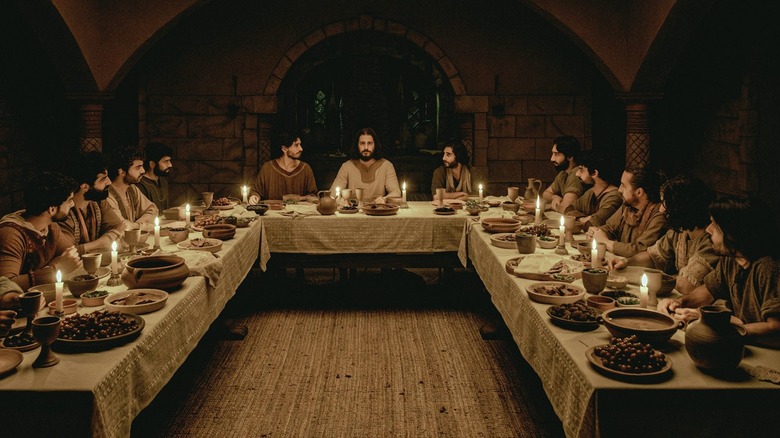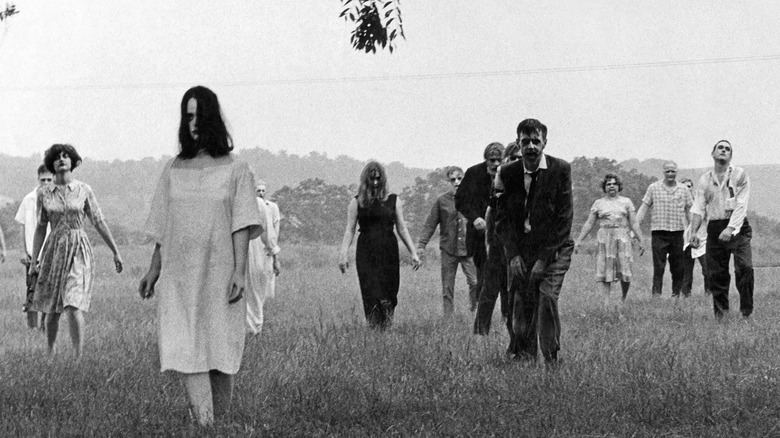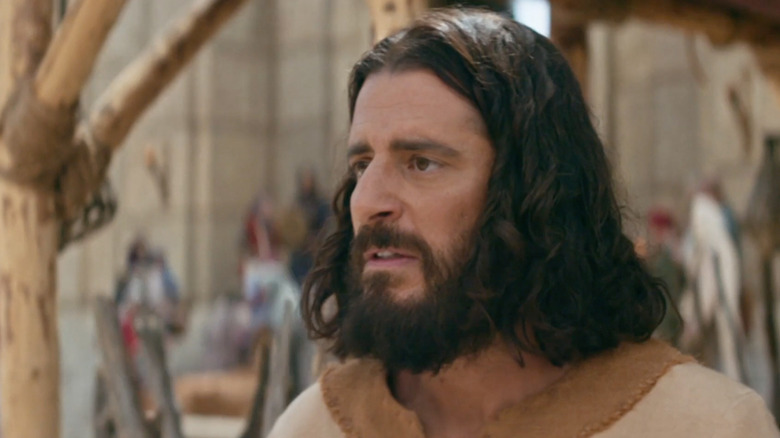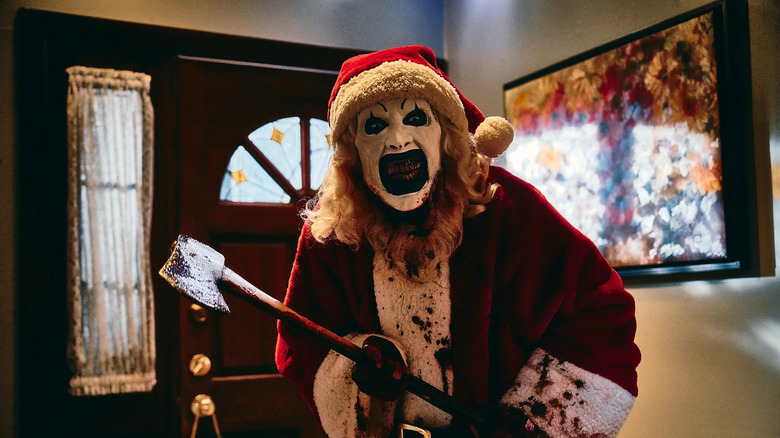The 10 Highest-Grossing Unrated Movies At The Box Office
Ever since the Motion Picture Association ratings system was established in late 1968 (when the organization was still called the Motion Picture Association of America), movie theaters have generally stuck to a rule of not booking unrated or, later, NC-17-rated movies. The notion is that such titles are too "salacious" to play in public multiplexes. Indie cinema and arthouse theaters have embraced features that eschew the MPAA (now MPA) ratings norms, but not being screened in the biggest theater chains — like AMC, Cinemark, and Regal — drastically reduces how much movies can make at the domestic box office. Plus, as members of the MPA, major movie studios like Warner Bros., Universal, and others don't release titles that bypass the ratings process.
Still, over the years, some smaller features have hit the big screen without any kind of MPA rating and managed to score solid box office numbers. In recent years, small distributor Cineverse has upended this entire institution with hit films like "Terrifier 2" and "Terrifier 3." With the unrated "The Toxic Avenger" sliming into theaters, it's a perfect time to look back at the 10 highest-grossing unrated movies ever at the domestic box office (excluding IMAX-exclusive documentaries, pre-1968 movies, and foreign language films).
Even removing those titles from the equation offers plenty of lucrative unrated films to break down, including analysis of why they abandoned the MPA rating system and how they brought audiences to theaters. As Art the Clown and Toxie can attest, you don't need an R or NC-17 moniker to be a big deal at the box office.
10. Croupier
Though he was a notable actor in Britain all throughout the 1990s, Clive Owen really blew up as a globally-acclaimed actor with 1998's "Croupier." Owen's subsequent movie and TV projects, like sci-fi all-timer "Children of Men," "The Knick," "Inside Man," and numerous others, wouldn't have been possible without his performance as Jack Manfred. In the Mike Hodges-directed film, croupier and writer Manfred becomes infatuated with the scheming Jani de Villiers (Alex Kingston), who has a plan to pull a fast one on Manfred's casino employers.
"Croupier" was released without an MPA rating upon its North American release in 2000 (which came two years after its United Kingdom premiere). It's not imemdiately clear why it went out unrated, but it could have something to do with the film's strange, beleaguered release history. The feature didn't take off in Britain and apparently struggled to gain any distribution in North America. Because of its small domestic release strategy (it was distributed in this territory by short-lived label Shooting Gallery), a proper MPA rating may have been seen as an expensive frivolity for a title that was never planned to play in many theaters.
Life, of course, has a funny way of upending expectations. Though it never played in more than 131 theaters, "Croupier" was a leggy indie throughout summer 2000 and eventually grossed a robust $6.2 million in North America. Owen's performance and the twisty narrative turned "Croupier" into a smash even without an MPA rating or British support.
9. The Aristocrats
There is a joke between comedians called "The Aristocrats," which involves a familiar setup and punchline but a middle section that's freely up for interpretation to any individual comic. While the ending line, "I call it 'The Aristocrats!'" endures, the grotesque material in the joke's middle varies depending on who's telling it. Directors Penn Jillette and Paul Provenza produced a 2005 documentary, fittingly titled "The Aristocrats," which interviewed an array of legendary comedians about the joke and its greater influence in the world of comedy.
Naturally, because of how filthy this joke can get (not to mention the inherently foul-mouthed tendencies of many of the film's interview subjects), "The Aristocrats" didn't even get a proper MPAA rating. It went out into theaters unrated, though some multiplexes, namely all AMC locations, declined to book such a lewd project. That didn't stop "The Aristocrats" from scoring a mighty box office haul, though. Despite playing in only a peak count of 234 theaters, the film grossed $6.3 million in 2005. That made it the second-biggest movie ever domestically from distributor ThinkFilm and a triumph for something so unabashedly abrasive.
On top of all that, documentaries are often perceived as having tremendously limited financial potential at the box office, unless they're a music doc or a Michael Moore film in the 2000s. "The Aristocrats" beat out all the odds, including those tied to its lack of an MPAA rating, to deliver a lucrative punchline for its financiers.
8. Eraserhead
David Lynch films defy descriptions. They're dream-like odysseys inspiring unprecedented emotions and responses from viewers. They also can't be contained in neat little boxes, including the MPA's rating norms. When it began its theatrical run in 1977, "Eraserhead" played as a midnight movie curiosity with no formal rating attached to it. Typically, going out unrated or with an NC-17 severely limits the amount of theaters you can play in, but a nightmare scenario for a big-budget studio picture wasn't really a concern for something as low-budget as "Eraserhead." It was never going to play in hundreds of theaters simultaneously, so why bother with a rating?
Plus, what kind of rating could you assign to a film so excitingly defiant of all conventional descriptors as "Eraserhead"? It's a disturbing experience, but not one marked by geysers of blood or explicit sex. The ominous tone comes from inexplicable visuals and its apocalyptic tone, rather than the graphic on-screen imagery of typical adult-skewing films. Even without a traditional rating, "Eraserhead" found its audience, grossing a tremendous $7 million over its various North American theatrical runs. That's an outstanding haul for something that cost only $100,000 to make.
The fact that "Eraserhead" hit those numbers despite being restricted in when it could play at theaters only amplifies how impressive its domestic release was. Just as all David Lynch movies upend conventions, "Eraserhead" capsized standards for how big unrated films could be financially.
7. Terrifier 2
There are no reported box office grosses for the initial theatrical run of the first "Terrifier," only its post-"Terrifier 2" re-release in 2023. That stark reality reflected the low expectations that greeted "Terrifier 2" as it bowed in theaters in October 2022. Though the gruesome style of extreme horror in "Terrifier" had a cult following, nobody could have predicted how much more popular "Terrifier 2" would become that Halloween.
After bowing in 886 theaters in its debut weekend, "Terrifier 2" earned more in its second weekend of release despite not drastically improving its theater count. That can be chalked up to the sequel's graphic content making it a must-see property for horror freaks. Such gnarly material wouldn't have been possible if "Terrifier 2" had played within R-rated cinema restrictions. Its unrated nature not only allowed the movie's most depraved kills to reach the big screen uncut. It also reflected that the movie was once set to play in theaters for only a week. Even if going out unrated "hurt" business, it would only amount to seven days of theatrical exhibition.
These plans went out the window as people turned out in droves to watch Art the Clown's rampage. Eventually, "Terrifier 2" grossed just over $10 million domestically, an outstanding win for this microbudget slice of transgressive filmmaking.
6. The Chosen: Last Supper -- Part 3
For some unrated movies, it's a great mystery why they didn't go through the MPA for a rating. For "The Chosen: Last Supper — Part 3," the answer was obvious: these were TV episodes brought to the big screen. Rather than being a big screen adaptation of a hit TV program, "The Chosen: Last Supper — Part 3" was the final segment in a series of films bringing "The Chosen" Season 5 episodes to theaters.
Given that "The Passion of the Christ" turned into a must-see moviegoing event for Christian audiences of all ages despite its explicit R-rated violence, it's clear that odd or potentially limiting MPA ratings don't deter faith-based audiences. Thus, going out unrated didn't deter "Last Supper — Part 3" from grossing an outstanding $11.68 million.
Even though audiences could watch this material in their homes in just a few months, the promise of experiencing these ancient tales in a communal setting just in time for Easter was too good a chance to pass up. With that, "Part 3" wrapped up 2025's "The Chosen" movies on a high financial note and without the aid of a standard MPA rating.
5. Night of the Living Dead (1968)
The initial MPA ratings system was established in November 1968, replacing the Hays Code that had been used to censor films since 1930. Released just a few short weeks before this system would forever change American cinema was "Night of the Living Dead," George A. Romero's zeitgeist-shattering zombie film. This downbeat film didn't adhere to any of the cozy rules of traditional horror fare, including its bleak ending in which racist white humans prove even deadlier to the protagonist than the undead. If the MPA rating system had existed at the time, it would have easily garnered an R moniker.
Apparently, some marketing material for "Night of the Living Dead" did allegedly feature an "X" marker to indicate to audiences just how gruesome the film was compared to standard 1960s horror cinema. However, that didn't stop many younger audience members from stumbling into the film and getting traumatized by what they were witnessing, as recounted in one of Roger Ebert's most evocative reviews. Not having to adhere to restrictive norms of what was "permissible" in certain MPAA ratings allowed Romero's imagination to run wild and redefine what American horror movies could look like.
Such a grim vision has proven enduringly fascinating to audiences all over. No wonder this project secured a $12 million domestic haul and influenced countless future horror movies, particularly any dealing with the undead.
4. The Chosen: Last Supper -- Part 1
While Fathom Entertainment has been in the theatrical release game for a good long while, the company was typically focused on theatrically re-releasing major studio titles for Sunday and Wednesday screenings. Starting in the late 2010s, though, Fathom began ramping up its annual output by embracing a slew of faith-based movies and special showings.
That commitment has resulted in some of Fathom's biggest successes ever, and this particularly lucrative cinematic niche also resulted in its first non-"Coraline" release to exceed $20 million+ domestically, with "The Chosen: Last Supper — Part 1." That title also smashed all expectations for how big an unrated movie could be at the domestic box office in the 2020s.
Right from the start, "The Chosen: Last Supper — Part 1" impressed with a massive $11.8 million debut from just 2,478 theaters. The idea that scores of theaters wouldn't screen unrated movies or that audiences wouldn't show up to features without a proper rating was clearly no match for the allure of a new movie starring Jesus Christ (Jonathan Roumie) and utilizing the "Chosen" brand name. In its lifetime domestic haul, "Last Supper — Part 1" grossed just over $20 million, topping the North American grosses of all but three Angel Studios releases. It was a holy theatrical run that opened up new horizons for how big Fathom Entertainment releases could be.
3. A Room with a View
Typically, post-1980 movies without an MPA rating intentionally bypass getting one, as they know their excessive gory violence or raunchy language will inevitably not fit an R moniker. That's what makes the case of 1986's "A Room with a View" so amusing. Director James Ivory's adaptation of the E.M. Forster novel of the same name has some brief frontal male nudity, but is otherwise a buttoned-up British costume drama that would have easily landed an R rating. Putting it on a list of TV episode compilations, "Terrifier" sequels, or lewd documentaries centered on stand-up comics is like putting the "Downton Abbey" crew in a police line-up with the Hell's Angels.
Whatever inspired "A Room with a View" to skip an MPA rating in its theatrical release, it certainly didn't curb its box office potential in North America. In the U.S. alone, the feature grossed $20.96 million, an impressive feat for such an unabashedly British production. Released in spring 1986, "A Room with a View" eventually scored eight Oscar nominations (including best picture and director), which added another $9 million at the box office in North America.
Those prestigious nods, plus its restrained material, likely helped "A Room with a View" score theatrical screenings in theaters that otherwise wouldn't have made room for unrated titles. Doing over six times its $3 million budget, this unorthodox, unrated drama was a dapper success.
2. Renaissance: A Film by Beyoncé
It's still not clear why "Renaissance: A Film by Beyoncé" wasn't given an MPA rating when it hit theaters in December 2023. Fellow 2023 AMC Theatres concert film "Taylor Swift: The Eras Tour" had a PG-13 rating, so it's not like these films were all skipping the rating system. Perhaps AMC was in such a hurry to get "Renaissance" into theaters in early December 2023 that nobody involved wanted to waste time getting into quarrels with the MPA over whether or not Beyoncé's songs "belonged" in a PG-13 or R-rated film. Plus, no theater was going to miss playing "Renaissance" just because it wasn't labeled either PG-13 or R. There was so much potential money to be made here that standard ratings procedures were superfluous.
Audiences certainly didn't blink at the lack of typical parental advisory warnings on the "Renaissance: A Film by Beyoncé" posters. The concert film reaffirmed this singer's legendary reputation by scoring the biggest post-Thanksgiving opening weekend in over 20 years. This typically cursed corridor produced financial success when Beyoncé was involved. After opening to an impressive $21.8 million, the film grossed $33.88 million domestically. Though a frontloaded enterprise, that was expected given its limited weekday play and intense competition for screens in late December.
Though its lack of an MPA rating is mysterious, the immense financial success of "Renaissance: A Film by Beyoncé" is indisputable.
1. Terrifier 3
The theatrical arrival of "Terrifier 2" was heralded by low expectations, and nobody thought this horror sequel would leave much of a financial mark before it suddenly exploded into a hit. Two years later, "Terrifier 3" had the opposite pre-release experience. Art the Clown was now a horror icon, and everybody was eager to see what stylized, nightmarish killings he'd exact on his innocent victims next. Living up to those expectations meant "Terrifier 3" once again went into theaters everywhere without an MPA rating, since there was no way that Art's particular style of carnage could be confined by R-rating restrictions.
Opening in over 2,500 locations, "Terrifier 3" grossed just over $21 million in its first four days of release, an astonishing sum for an unrated movie and one dabbling in such extreme horror. Grotesque imagery drove people to theaters instead of repelling them. The good times just kept on rolling for this gruesome property, as it eventually grossed $53.98 million domestically. That was enough to make "Terrifier 3" the first unrated movie to clear $35 million (let alone $50 million) in North America, leaving the lifetime domestic totals of every single NC-17 feature in the dust. All financial wisdom on what "can" and "should" be a theatrical success in America was now thrown out the window.
"Terrifer 3" didn't just see Art dismember teenagers in the grossest ways possible. This clown also obliterated once and for all the concept that unrated movies would never make money theatrically. Who knows where future exploits of this character will take audiences — and the box office.
